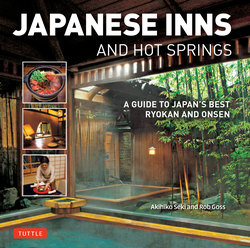Читать книгу Japanese Inns and Hot Springs - Rob Goss - Страница 8
На сайте Литреса книга снята с продажи.
ОглавлениеA GUIDE TO RYOKAN ETIQUETTE
Entire books have been written on Japanese business etiquette and social manners. In the most part, the intricacies don’t apply to tourists—just use universal good manners and you’ll be fine—but there are some particular rules for the ryokan that you should do your best to follow.
When to Remove Your Shoes
In the majority of ryokan, you take off your shoes in the entrance area before stepping into the ryokan, store them in the lockers or on the shoe shelves available, and then change into slippers to be worn around the communal areas of the ryokan. When you get to your room, you then remove your slippers at the room’s genkan (the small entrance area), going barefoot or in socks on the tatami mats. There can be variations, of course—some ryokan, for example, allow shoes throughout the communal areas, but you then take these off at your genkan—which can make things a little confusing. A simple guideline is to never step on tatami with shoes or slippers on and, wherever else, look out for slippers. If slippers are laid out, it’s a good bet you should be using them.
At Asaba (pages 40–45), you are personally greeted by the okami who will look after you during your stay. Remember to remove your shoes at the entrance! (She will store them for you.)
Luggage
As well as removing your shoes at the entrance, at most ryokan this is also where staff will collect your luggage from you. If you end up carrying your own luggage to your room, lift it up if you can, so that the wheels don’t bring in dirt from outside or damage the flooring. In your room, don’t keep the luggage on the tatami or in the tokonoma. There will be closets or other areas to leave it.
Kinmata (pages 96–99). Your luggage will be brought to your room. Be very careful not to damage the tatami mats, paper screens and furniture in the room or public areas. If anything is damaged, you might be asked to pay for the cost of repairing or replacing the items.
Hiiragaya (pages 90–95). Paper shoji screens are exquisitely beautiful but also extremely fragile. Please be careful when opening them.
Bath Time
First up, change into the cotton yukata gown left for you in your room before going to the bathhouse (you can wear this throughout your stay), and take one of the room towels with you as not all ryokan have towels in the bathhouse. Once there, get naked, leaving your yukata and anything else in one of the wicker baskets or lockers in the changing room next to the actual bath room. Unless you are at a mixed-gender bath (although many of these are nude only, too) the only thing allowed in the bath is you—no bathing shorts, towels, or anything else to protect your modesty.
Next, the most important thing is to wash before getting in the bath. As a foreigner, you can be forgiven for many faux pas in Japan, but polluting a communal bath with soap or dirt is one cardinal sin that nobody gets away with. Before getting in the bath for a long, hot soak, take a seat on one of the little stools by the low showers and wash and fully rinse (making sure to rinse off any soap and bubbles from the stool too) before heading for the bath. Enter the bath gently, as it’s rude to disturb the water too much, and then relax.
Tipping
Basically speaking: no. Whether at a taxi, restaurant, hotel or anywhere else, tipping is very rarely done in Japan. In almost all situations, simply trying to tip someone would cause embarrassment. That said, with very high-end ryokan there is an old custom (seldom followed nowadays) of offering a gratuity for staff who were particularly helpful. This is done by slipping a little cash (¥2,000 to ¥3,000) into an envelope and discreetly handing it over. Again, you aren’t expected to do this (quite the opposite), and you may be politely refused. If you want to leave something to say thank you for a great stay, give the staff a box of cookies or something similar when you check out. Really, though, a genuine thank you and smile is more than enough.
The first course of a meal at Kinmata (pages 96–99). Breakfast and dinner at a ryokan are both lavish affairs requiring many hours of preparation by the kitchen. You will be asked to confirm your preferred meal times in advance. Be punctual to avoid disrupting the ryokan's carefully choreographed schedule.
Noise Levels
You don’t have to whisper or walk around like you are on eggshells, but the peace and quiet is something that makes ryokan so special. In common areas especially, a little common sense will go a long way when it comes to noise and, if you are traveling with kids, make sure they aren’t running amok.
Meals
Ingredients are ordered to meet the day’s demand, so don’t make any last-minute menu requests as the ryokan might not be able to accommodate them. If you have special dietary requirements, let the ryokan know before you arrive. Be aware that dinner timings tend not to be flexible, beyond perhaps the choice of dinner at 6:30 or 7pm, as the chefs will cook all the intricate dishes at one time on a tight schedule, to be served at once. When you’ve set the time, you need to stick to it. Ryokan won’t hold a meal for you, as they won’t want to serve food that isn’t at its freshest.
